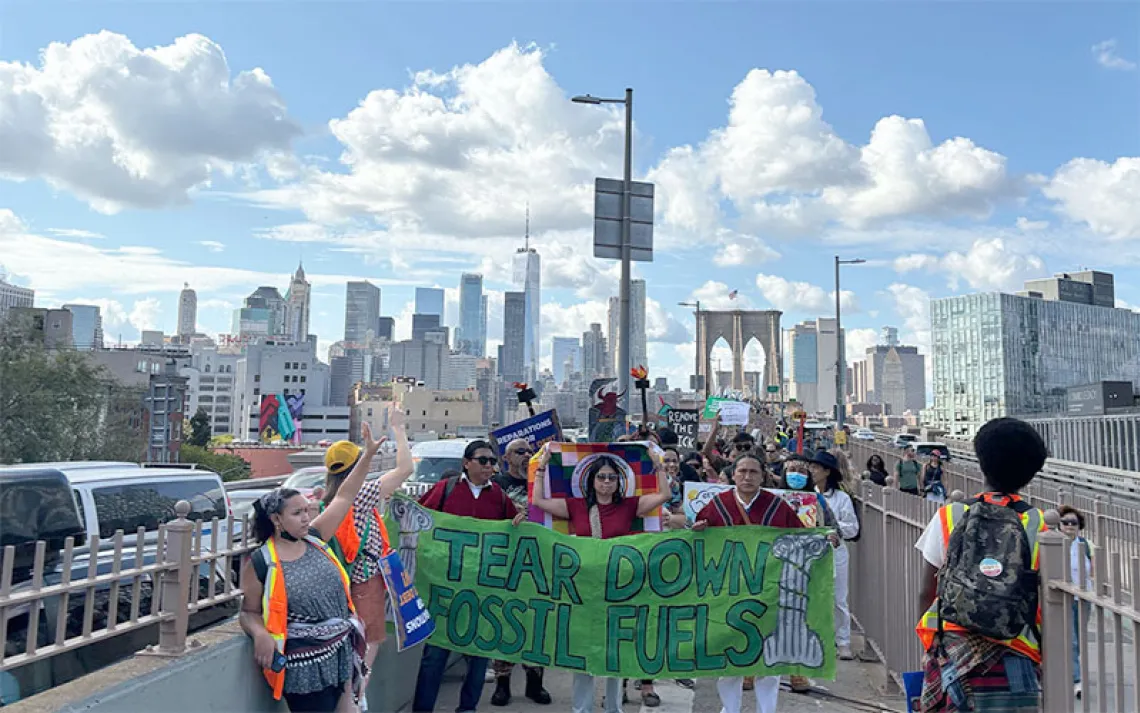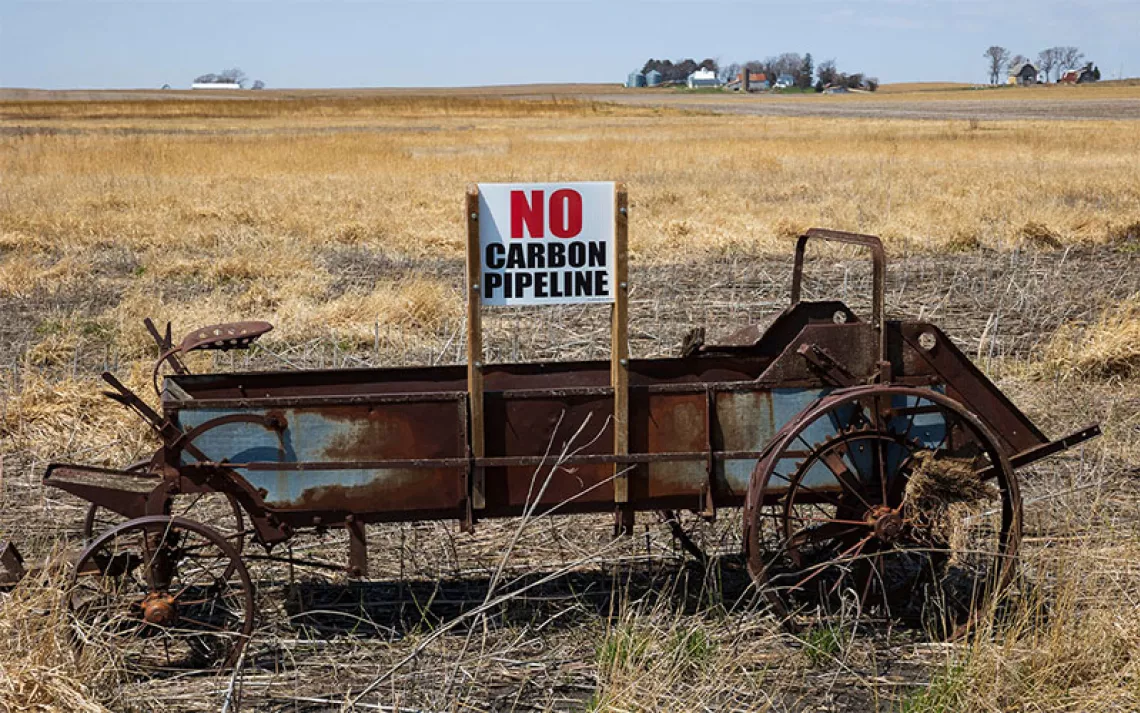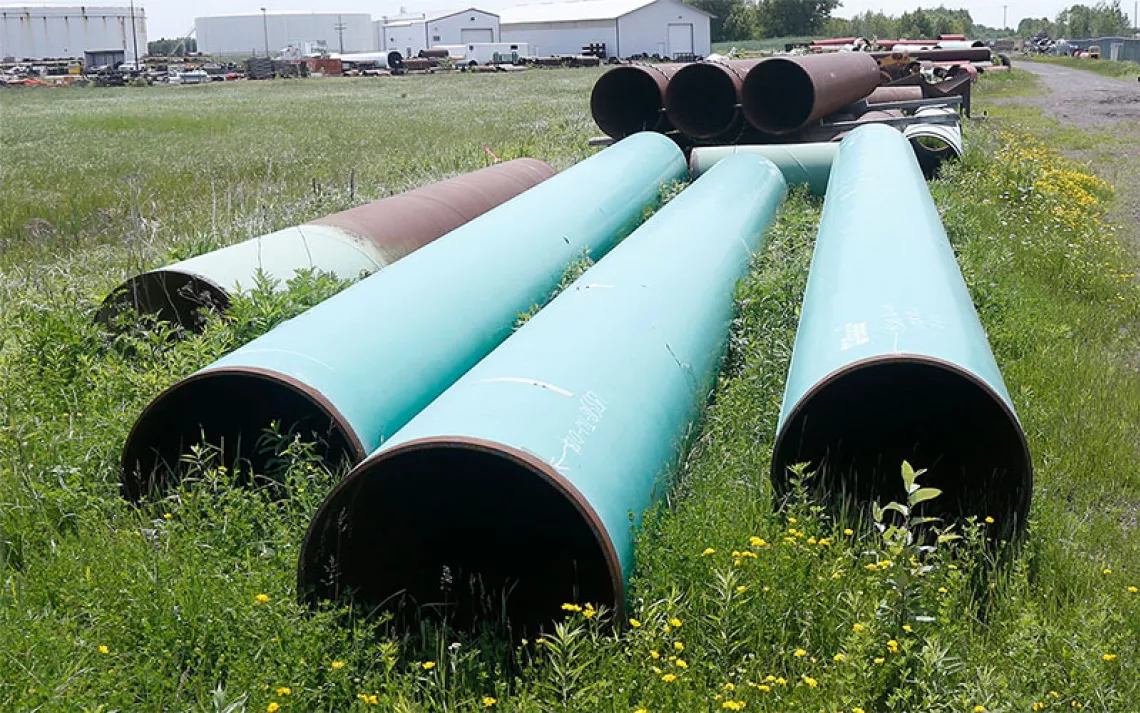Obama Administration’s Suspension of Contested Dakota Access Pipeline Construction Demonstrates Strength of Indigenous Climate Justice Movement

Standing Rock, ND—For Bethany Crawford, a member of the Standing Rock Sioux and great grand niece of the legendary Lakota leader Sitting Bull, the Obama administration’s surprise decision Friday afternoon to suspend construction on the fiercely contested Dakota Access pipeline was a testament to the power of prayer.
“My heart is singing so hard because of this decision,” she told Sierra magazine, her eyes filled with tears of joy as she sat in her truck at Oceti Sakowin Camp, the site where thousands of native activists and allies opposed to the pipeline have converged in recent weeks. “The elders that I’ve seen cry—I’ve never seen them express themselves that way.”
For five months, Standing Rock Sioux members along with other native allies have been camped alongside the Missouri River in a show of resistance against the pipeline. Beginning in North Dakota’s oil-rich Bakken region, the 1,172-mile pipeline, if completed, would dip under the Missouri River on its way to South Dakota, Iowa, then finally Illinois. At 30 inches in diameter, it would funnel more than 570,000 barrels of crude oil through the region every day.
The Standing Rock Sioux worry that a pipeline rupture would cause serious environmental damage to the Missouri River watershed. They also say that some sections of the pipeline—which would pass just a half mile from their reservation and through land that once belonged to the tribe until seized by the U.S. government in 1958—have already disturbed sacred burial grounds.
The tribe filed an emergency petition with the federal government in an effort to stop pipeline construction. On Friday, a federal district court ruled that construction could move forward, dashing the hopes of the indigenous activists opposed to the project. But just moments later, the U.S. Department of Justice, the Department of the Interior, and the Army Corps of Engineers issued a sweeping statement announcing a suspension of construction until a comprehensive legal review is conducted.

The statement was striking for the way in which it acknowledged the tribal sovereignty issues at play. “This case has highlighted the need for a serious discussion on whether there should be nationwide reform with respect to considering tribes’ views on these types of infrastructure projects,” the federal agencies said. “Therefore, this fall, we will invite tribes to formal, government-to-government consultations.”
While the statement doesn’t order the $3.8 billion project’s abandonment, it does indefinitely halt construction on its most contested portion: a section slated to run near and under the Missouri River. In the event of an oil spill or pipeline rupture, the Standing Rock Sioux Reservation, located just downstream of the pipeline route, would be immediately affected. In addition to contaminating drinking and irrigation water for Standing Rock and others living along the Missouri, an oil spill, depending on scale, could have devastating effects on the area’s ecology.
“The Missouri River is one of the largest water systems in the United States,” Dallas Goldtooth (Dakota, Diné) of Indigenous Environmental Network (IEN) told Sierra. “An oil spill here would not only be possible, but its effects would be vast and catastrophic.”
“This area is a nesting ground for eagles,” Joye Braun (Northern Cheyenne Sioux) of IEN said. “I just saw river otters and pelicans in the water the other day. There are endangered fish in there, too. Someone from our tribe went medicine gathering along the riverbank recently and within 15 minutes found 57 different plants used for medicine.”
To call attention to the pipeline threat, a "spirit camp" was established on the northern tip of the reservation in early April. What began as something small has since swelled into a giant resistance encampment. Between 3,000 and 5,000 people (depending on the day) are now occupying a flat expanse of prairie hugging the banks of the Missouri River. The sprawling assortment of tents, tepees, vehicles, and round pens for horses overflows onto adjacent Army Corps of Engineers land. In the evenings, those surrounding hills echo with the sounds of singing and drumming rising from the enclave below.
“The camp is an entity all its own,” said LaDonna Brave Bull Allard (Standing Rock Sioux), who owns the property where the resistance camp initially sprung up. “It evolved. People just started coming, helping, and standing with us. In my vision, I never imagined this.”
“This location is actually a traditional campground,” she continued. “This is where people came. This was a major trade area where all tribes were welcome.”
The Standing Rock Sioux’s legal battle against the Dakota Access pipeline has become the latest symbolic flashpoint of an emboldened tribal sovereignty movement focused on climate justice. Across North America, indigenous nations are fighting for their treaty rights in a show of force not seen since the 1970s heyday of American Indian Movement activism.
In the Pacific Northwest, the Lummi Nation scored a major victory earlier this year when the federal government agreed that construction of a massive coal-export port outside of Bellingham, Washington, would violate their treaty agreements. In the Southwest, the San Carlos Apache have been waging a battle against a proposed copper mine on land they consider sacred; in March, the Obama administration moved to place the site, called Oak Flat, on the National Register of Historic Places, which would prevent mine development. Plains tribes played a major role in the defeat of the proposed Keystone XL tar sands pipeline, and Sioux tribal members have engaged in acts of civil disobedience to prevent equipment destined for the Canadian tar sands from crossing their lands.
The renewed spirit of resistance and inter-tribal solidarity has been on display at Oceti Sakowin Camp, which has attracted supporters from nearly 300 nations across the continent. The people camped there say they aren’t “protesters”; instead, they claim the term “protectors.”

"There are two kinds of laws," Winona LaDuke (Ojibwe), an indigenous activist, said to campers during a concert at Oceti Sakowin Camp. "The white man's law and the Creator's law."
John Garcia, a member of Alaska’s Tlingit Tribe, was among those that answered the call for other native activists to join the camp on the Missouri. After getting picked up in Seattle by a relative that started his own journey in Juneau, Alaska, with a canoe in tow, they drove to North Dakota. Along with about 10 other tribes from all over the Pacific Northwest, Garcia participated in a solidarity paddle that put in at Bismarck, North Dakota, and reached the shores of Oceti Sakowin Camp on September 7.
“There was no way we could say no,” Garcia said. “We’ve had the same struggle in Alaska with the Exxon Valdez spill 27 years ago now. We still have ecological issues that are long-lasting into the next generation. We absolutely had to stand up and have our voice heard along with Standing Rock’s.”
Hanford McCloud of Washington’s Nisqually tribe echoed the same feeling as he addressed the crowded shore of indigenous people and allies after the solidarity paddle reached Oceti Sakowin Camp.
“Our people understand what we’re doing here for you as we came across Turtle Island to be with you,” McCloud said. “We brought 60 people with us in eight cars. We brought our young ones, our royalty, our elders here to witness this. . . . As native people, as coastal people . . . we’ve stood up and fought for the fishing rights in our area. We’re here to help bring that energy and those prayers to you.”
“Bosco” Wade Jr. (Choctaw, Pawnee) traveled from Oklahoma to join Oceti Sakowin Camp.
Though he joked about the Pawnee and Sioux Nations being historic enemies, Wade was humbled by the opportunity to participate in a traditional Lakota pipe ceremony at the camp.
“There is so much powerful spirit here,” he told Sierra. “This isn’t happening just for us, it’s for the world. It’s for our children.”
For Standing Rock and other native nations, the Obama administration’s suspension of the pipeline, though a small victory within what will inevitably evolve into a drawn-out legal battle, demonstrates the strength of tribal nations’ commitment to climate justice.
“The people that are putting the pipeline in don’t have to live here,” Bethany Crawford said. “One day, I hope their hearts can open to how beautiful nature is. It’s not over, but it’s a good step.”
For now at least, she knows the Missouri River is safe.
WHAT YOU CAN DO
Urge President Obama to stand with tribes to protect our environment by repealing the approval of this dangerous fracked oil pipeline through the Midwest! Send a message today to help stop the toxic Dakota Access pipeline.
 The Magazine of The Sierra Club
The Magazine of The Sierra Club



